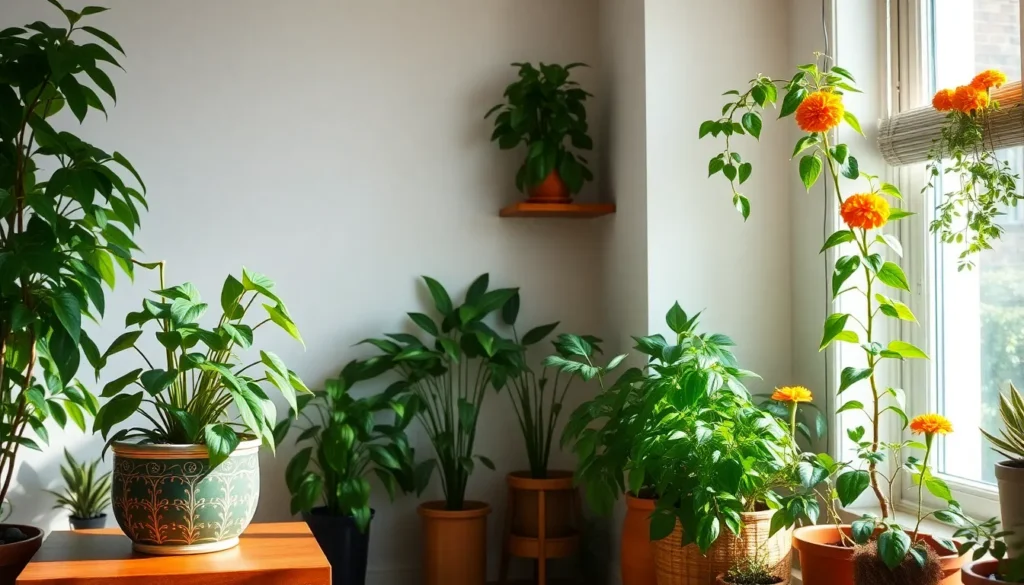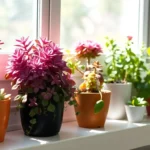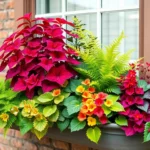We’ve all felt the difference a thriving plant makes in our living space – that instant boost of positive energy and natural beauty. But what if we told you that choosing the right plants could actually transform your home’s energy flow according to ancient Vastu principles?
Vastu Shastra teaches us that certain plants don’t just purify our air and brighten our rooms – they actively attract prosperity wealth and harmony into our homes. From the money-drawing properties of jade plants to the protective energy of tulsi these green companions work as natural energy enhancers that align with cosmic forces.
Whether you’re dealing with a cramped apartment or a spacious house we’ll show you exactly which Vastu-approved plants belong in each room and direction. Get ready to discover how simple plant placement can shift your home’s energy from stagnant to spectacular.
Money Plant: The Ultimate Prosperity Magnet for Your Home
Money plants rank among the most powerful Vastu-compliant plants for attracting wealth and abundance into our living spaces. We’ve witnessed countless homeowners transform their financial energy by incorporating this versatile green companion into their home design.
Best Placement According to Vastu Principles
Southeast corners provide the ideal location for money plants since this direction aligns with Lord Ganesha’s energy and attracts material prosperity. We recommend placing your money plant in the living room’s southeast section to maximize wealth attraction and positive cash flow.
North and east directions also support money plant placement because these areas naturally enhance growth energy and new opportunities. Living rooms benefit most from money plant positioning since family members spend considerable time in these spaces, allowing the plant’s prosperity vibrations to influence everyone.
Avoid placing money plants in bedrooms or bathrooms as these locations can drain the plant’s wealth-generating properties. We suggest keeping money plants away from sharp corners and clutter to maintain their energy flow and effectiveness.
Indoor spaces with bright, indirect sunlight work best for money plant placement since direct sunlight can scorch their delicate leaves. Corner tables, wall-mounted planters, and decorative stands create excellent positioning options that align with proper Vastu guidelines.
Care Tips for Maximum Positive Energy
Watering money plants every 2-3 days maintains their vibrant energy and ensures consistent prosperity attraction throughout your home. We recommend using filtered or distilled water to prevent mineral buildup that can block the plant’s natural energy channels.
Pruning dead or yellowing leaves immediately prevents negative energy accumulation and keeps your money plant’s wealth-attracting properties at peak performance. Regular leaf cleaning with a damp cloth removes dust and allows the plant to breathe properly, improving its positive vibrations.
Fertilizing monthly with organic compost strengthens your money plant’s root system and amplifies its ability to attract financial abundance. We suggest using natural fertilizers rather than chemical ones to maintain the plant’s pure energy signature.
Repotting annually or when roots become crowded ensures your money plant continues growing and expanding its prosperity influence. Choose terracotta or ceramic pots over plastic containers since natural materials enhance the plant’s Vastu compliance and energy flow.
Talking to your money plant daily and expressing gratitude creates a positive energy exchange that multiplies its wealth-attracting capabilities. We’ve observed that homeowners who maintain this practice often experience faster financial improvements and increased opportunities.
Tulsi Plant: Sacred Protection and Purification
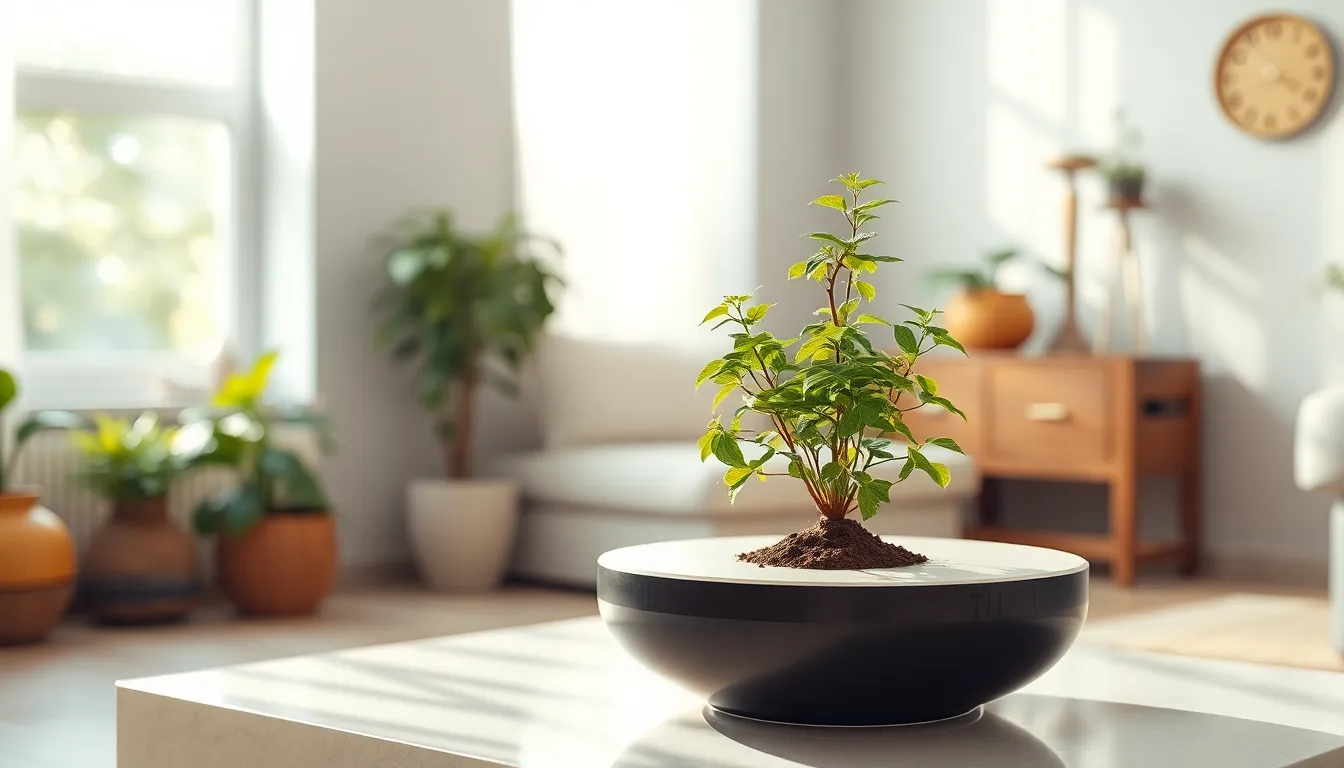
We consider the Tulsi plant a cornerstone of Vastu practice, offering unmatched spiritual benefits that extend far beyond typical houseplants. This sacred herb transforms our living spaces into sanctuaries of positive energy and divine protection.
Traditional Significance in Vastu Shastra
Negative energy removal forms the primary function of Tulsi in our homes, as this holy basil actively purifies surroundings and attracts positive vibrations that bring blessings, health, and prosperity to residents. Ancient Vastu texts emphasize Tulsi’s connection to Goddess Lakshmi and Lord Vishnu, making it essential for Hindu households seeking divine favor.
Spiritual vibrations intensify when we use Tulsi leaves in rituals like Panchamrita and daily prayer offerings, creating a direct channel to please deities and generate powerful positive energy throughout our living spaces. Worshiping this sacred plant gives us strength to fight evil forces and sinful activities while promoting peace and harmony in our households.
Protection against negativity becomes automatic when we maintain a healthy Tulsi plant, as its presence acts as a spiritual shield that wards off harmful influences and maintains the sanctity of our home environment. The plant’s association with divine entities makes it a powerful ally in our search for spiritual growth and material prosperity.
Ideal Locations for Tulsi Placement
North or northeast directions provide the most beneficial placement for our Tulsi plants, aligning them with natural positive energy flows since the northeast connects to water elements and enhanced positivity according to Vastu principles. These directions maximize the plant’s ability to channel divine blessings throughout our living spaces.
Main entrance positioning offers excellent protection for our households, as placing Tulsi near entry points helps shield us from negative influences while inviting auspicious vibrations into our homes. This strategic placement creates a protective barrier that filters energy before it enters our personal sanctuary.
Elevated platform requirements ensure proper Vastu compliance when we position our Tulsi plants on raised surfaces higher than our home’s foundation, maintaining them in clean, clutter free spaces that honor their sacred nature. The platform should remain pristine and dedicated solely to the plant’s care and worship.
Odd number cultivation enhances spiritual benefits when we grow Tulsi plants in quantities of one, three, or five, avoiding placement near thorny plants like cacti that can interfere with their positive energy emission. This numerical consideration amplifies the plant’s protective and purifying properties throughout our living environment.
Bamboo Plant: Bringing Growth and Good Fortune
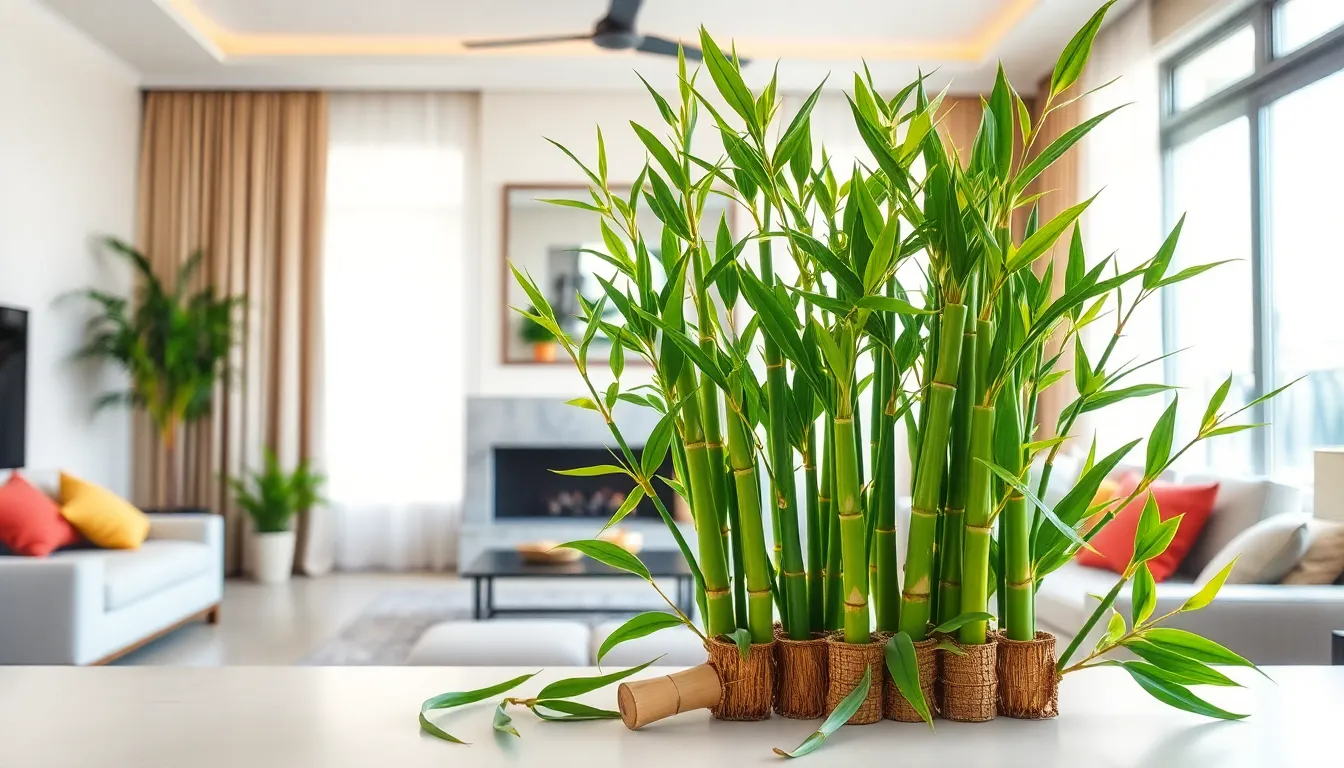
Lucky bamboo stands out as one of nature’s most powerful symbols for attracting prosperity and positive energy into our homes. This remarkable plant embodies resilience, flexibility, and continuous growth, making it an essential addition to any Vastu-compliant living space.
Lucky Bamboo Arrangements for Different Rooms
Three stalks create the perfect foundation for happiness, longevity, and wealth in our living spaces. We recommend starting with this arrangement if you’re new to incorporating bamboo into your home’s energy system.
Five stalks amplify both health and financial abundance, making them ideal for families seeking comprehensive well-being. Place these arrangements in areas where the family gathers most frequently.
Eight stalks accelerate growth and prosperity, particularly beneficial for career advancement and business success. We suggest positioning eight-stalk arrangements in home offices or study areas.
Nine stalks represent the ultimate lucky configuration, bringing exceptional fortune and blessings. These powerful arrangements work best in main living areas where their energy can radiate throughout the home.
Twenty-one stalks channel blessings from multiple sources, creating an abundance network that supports all family members. Reserve this elaborate arrangement for spacious areas that can accommodate its impressive energy flow.
Living rooms and entrances benefit most from any bamboo arrangement, as these spaces naturally distribute positive energy throughout the home.
Office spaces and study rooms thrive with bamboo’s concentration-improving properties, supporting mental clarity and professional growth.
Bedrooms require careful consideration, as bamboo’s vibrant energy might disrupt peaceful sleep patterns.
Vastu Guidelines for Bamboo Positioning
East and Southeast directions provide optimal placement for lucky bamboo, aligning with natural energy flows that govern health and wealth. We consistently see the best results when bamboo occupies these powerful directional zones.
Clean surfaces with fresh water create the ideal foundation for bamboo’s energy transmission. Change the water regularly to maintain the plant’s vitality and energy-conducting properties.
Healthy, vibrant plants generate positive vibrations, while withered or struggling bamboo can create adverse effects. Monitor your bamboo’s condition daily and address any health issues immediately.
Northwest and South corners should be avoided for bamboo placement, as these directions can create energy instability. We’ve observed that bamboo positioned in these areas often fails to thrive and may negatively impact household harmony.
Elevated positioning enhances bamboo’s ability to channel positive energy throughout the room. Use clean, natural platforms or stands to lift your bamboo arrangements above floor level.
Jade Plant: Attracting Wealth and Success
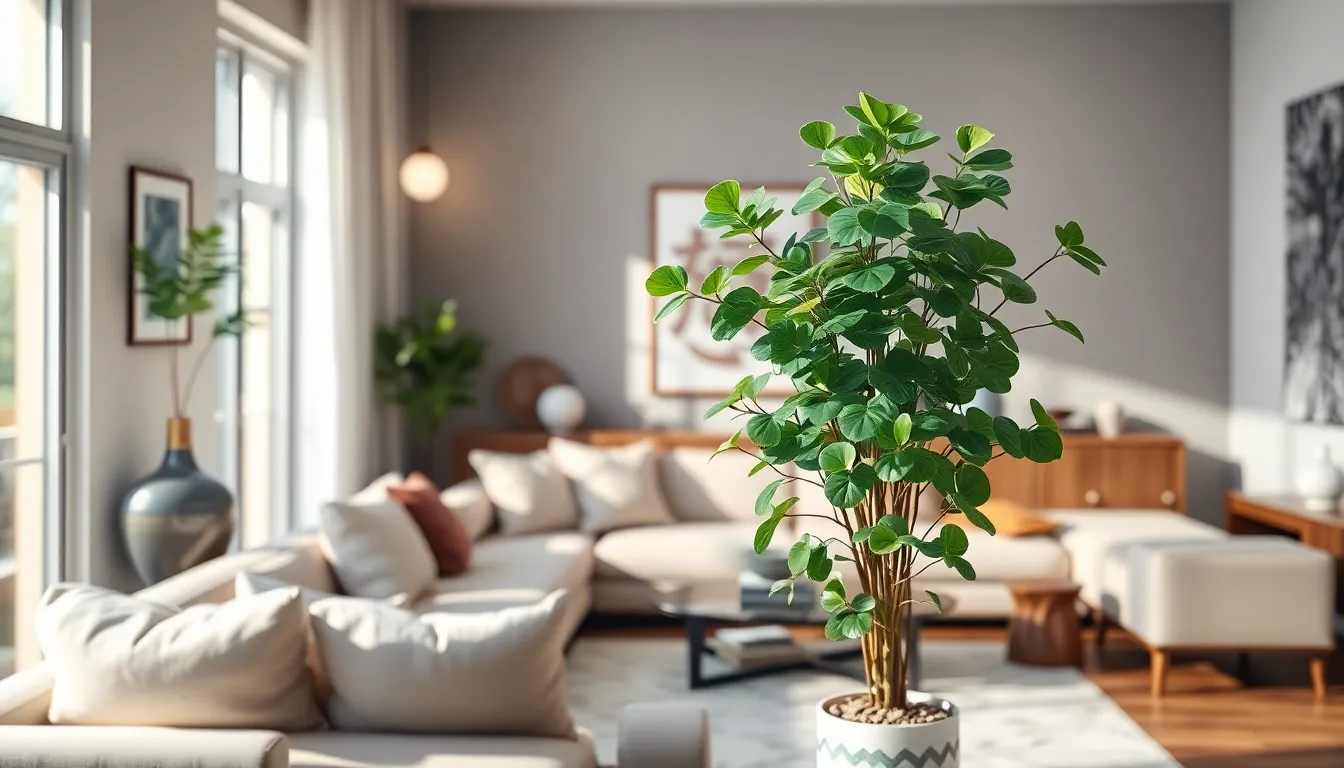
We’ve discovered that the Jade Plant stands out as one of the most powerful wealth-attracting plants in Vastu Shastra. Its thick, coin-shaped leaves symbolize financial growth and continuous prosperity for our homes.
Feng Shui vs Vastu Considerations
Both ancient practices recognize the Jade Plant’s wealth-attracting properties, but they approach placement differently:
Feng Shui focuses on balancing five elements – wood, fire, earth, metal, and water – to promote harmony and chi flow throughout our living spaces. The practice emphasizes the plant’s ability to bring good luck and maintain energetic balance in any room.
Vastu Shastra prioritizes directional placement based on cardinal points and cosmic energies for maximum prosperity attraction. We should position our Jade Plant in the southeast area of our home or workplace to enhance career advancement and business opportunities.
Energy cleansing differs between the two systems as Vastu emphasizes the plant’s psychic shielding effects while Feng Shui concentrates on continuous energy flow. Both practices agree that the Jade Plant’s vigorous growth represents vitality and new beginnings.
Maintenance for Continuous Prosperity
Proper care ensures our Jade Plant continuously attracts wealth and positive energy:
Lighting requirements include bright, indirect sunlight to stimulate healthy growth and maintain the plant’s prosperity-attracting properties. Direct harsh sunlight can damage the leaves and reduce their symbolic coin-like appearance.
Watering needs moderate consistency since the Jade Plant tolerates drought but requires steady moisture without overwatering. Soggy soil leads to root rot and diminishes the plant’s wealth-generating capabilities.
Soil composition should feature well-draining mixtures to prevent water accumulation and maintain healthy root systems. Quality soil directly impacts the plant’s ability to channel positive energy.
Pruning schedules encourage new growth and help maintain the plant’s shape for optimal energy flow. Regular trimming also removes any negative energy that might accumulate in dead or dying leaves.
Environmental placement requires clean, positive corners free from clutter or stagnant energy that could block prosperity flow. Some Vastu experts suggest occasionally cleansing the plant with water and keeping it dust-free to maintain its positive energy transmission.
Aloe Vera: Healing Energy and Positive Vibes
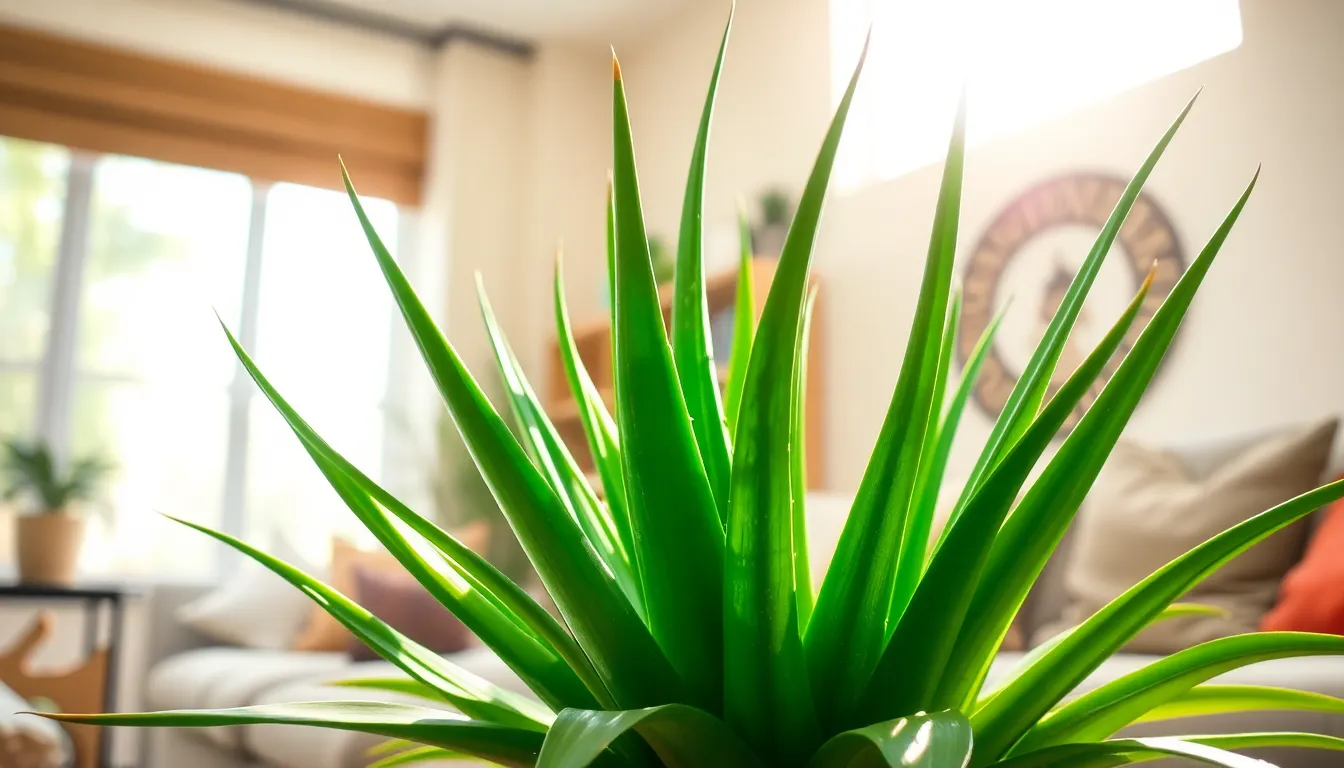
Aloe Vera stands as one of Vastu Shastra’s most powerful healing plants, offering both physical wellness and spiritual purification for our homes. We recognize this succulent as an exceptional air purifier that removes negative energies while fostering an environment of health and vitality.
Health Benefits Aligned with Vastu Principles
Physical wellness receives a important boost when we incorporate Aloe Vera into our living spaces according to Vastu guidelines. The plant’s natural antibacterial properties create a healthier home environment by purifying the air and removing harmful toxins from our surroundings.
Mental clarity improves dramatically as Aloe Vera helps reduce stress levels and promotes overall wellness by stabilizing our home’s energy balance. We benefit from the plant’s ability to enhance the flow of positive energy throughout our space, creating a more harmonious atmosphere for daily living.
Spiritual healing occurs naturally through Aloe Vera’s powerful purifying qualities that complement its physical health benefits. The plant acts as a holistic addition to any living space, combining ancient Vastu wisdom with modern wellness practices to support our complete well-being.
Strategic Placement for Maximum Benefits
East and north directions provide the optimal placement locations for Aloe Vera according to traditional Vastu guidelines. We recommend positioning the plant in these areas to maximize its ability to absorb negative energies and amplify positive vibrations throughout our entire home.
Living rooms, kitchens, and balconies serve as ideal locations for our Aloe Vera plants, offering the perfect balance of light and energy flow. These spaces allow the plant to thrive while effectively purifying the air and maintaining positive energy circulation.
Bedroom avoidance becomes essential since Aloe Vera’s sharp leaves might generate aggressive energy that disrupts peaceful sleep patterns. We suggest keeping these powerful plants in common areas where their healing properties can benefit the entire household without affecting rest quality.
Regular maintenance ensures our Aloe Vera plants remain vibrant and continue bringing good health and prosperity to our homes. Proper care includes adequate watering, appropriate lighting, and occasional pruning to maintain the plant’s energy flow and maximize its Vastu benefits.
Peace Lily: Promoting Harmony and Tranquility
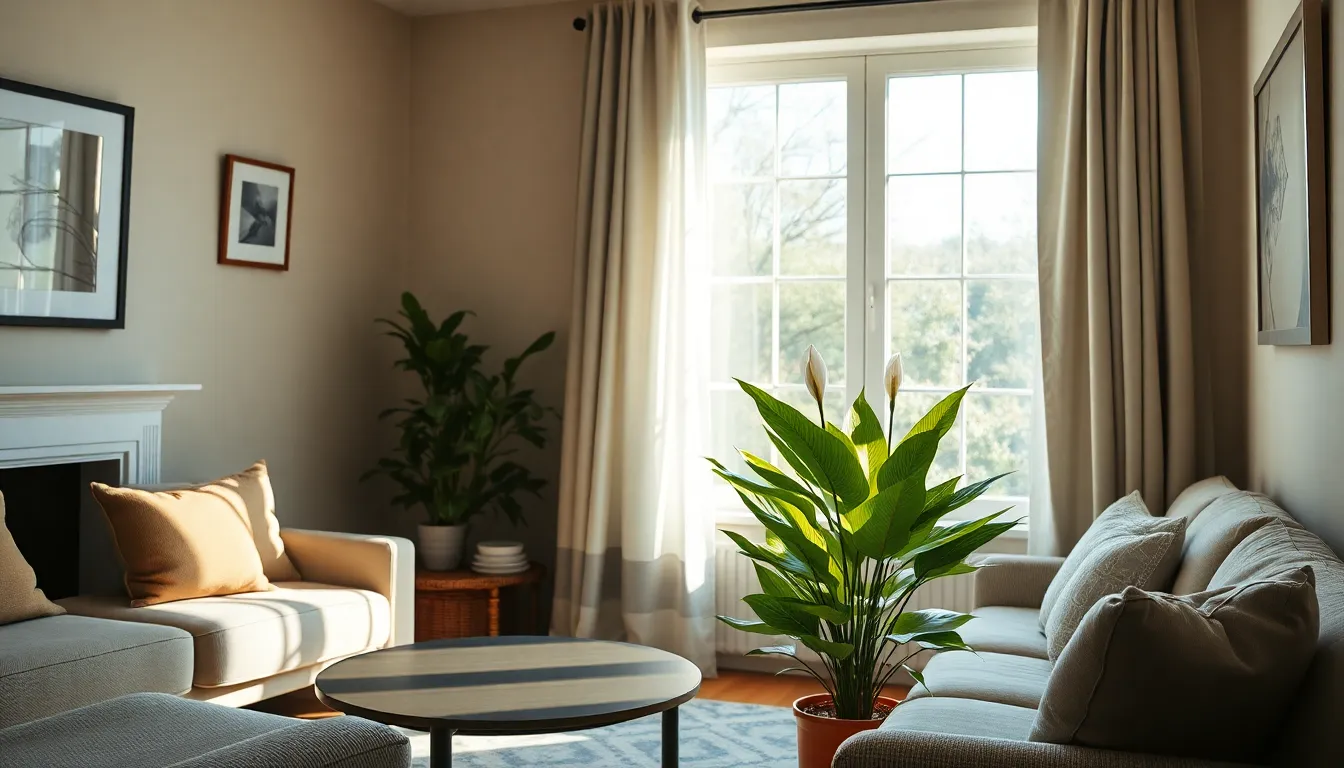
Peace lilies stand out as exceptional Vastu plants that bring serenity and balance to our living spaces. We’ve found these elegant plants offer both practical and spiritual benefits that align perfectly with Vastu principles.
Air Purification and Spiritual Benefits
Peace lilies excel at removing toxins from indoor air, creating a healthier environment that naturally reduces stress levels. NASA studies confirm these plants filter harmful chemicals while releasing oxygen, contributing to improved wellbeing throughout our homes.
Beyond their practical benefits, peace lilies carry profound spiritual significance in Vastu Shastra. Their pristine white flowers symbolize purity, calmness, and inner peace, generating positive energy that flows harmoniously through our living spaces. We particularly value how these blooms represent tranquility and positivity, making them ideal companions for meditation areas and quiet corners where we seek mental clarity.
The plant’s gentle energy promotes emotional balance while fostering an atmosphere of serenity. Spiritually conscious homeowners often choose peace lilies to enhance their connection with peaceful vibrations and create sanctuaries within their homes.
Vastu-Compliant Positioning Guidelines
Strategic placement maximizes the peace lily’s beneficial effects according to Vastu principles. We recommend positioning these plants in the east or north directions of our homes, where they naturally attract positive energy and enhance overall harmony.
Living rooms and hallways serve as optimal locations for peace lilies, particularly near windows that provide indirect sunlight. These common areas allow the plant’s peaceful energy to circulate throughout our daily activities, creating a calming influence for family members and guests.
Certain areas should be avoided to maintain proper energy balance. Bedrooms and kitchens aren’t suitable locations for peace lilies, as these spaces can interfere with the plant’s ability to channel tranquil vibrations effectively. Proper lighting conditions also matter significantly – indirect sunlight ensures the plant thrives while maintaining its energy improving properties.
| Placement Factor | Recommended | Avoid |
|---|---|---|
| Direction | East, North | Southwest, Northwest |
| Rooms | Living room, Hallway | Bedroom, Kitchen |
| Lighting | Indirect sunlight | Direct harsh sun |
| Position | Near windows, Open spaces | Dark corners, Cluttered areas |
Elevated positioning on plant stands or decorative pedestals amplifies the peace lily’s energy transmission throughout our homes, ensuring its harmonizing effects reach maximum potential.
Snake Plant: Protective Shield Against Negative Energy
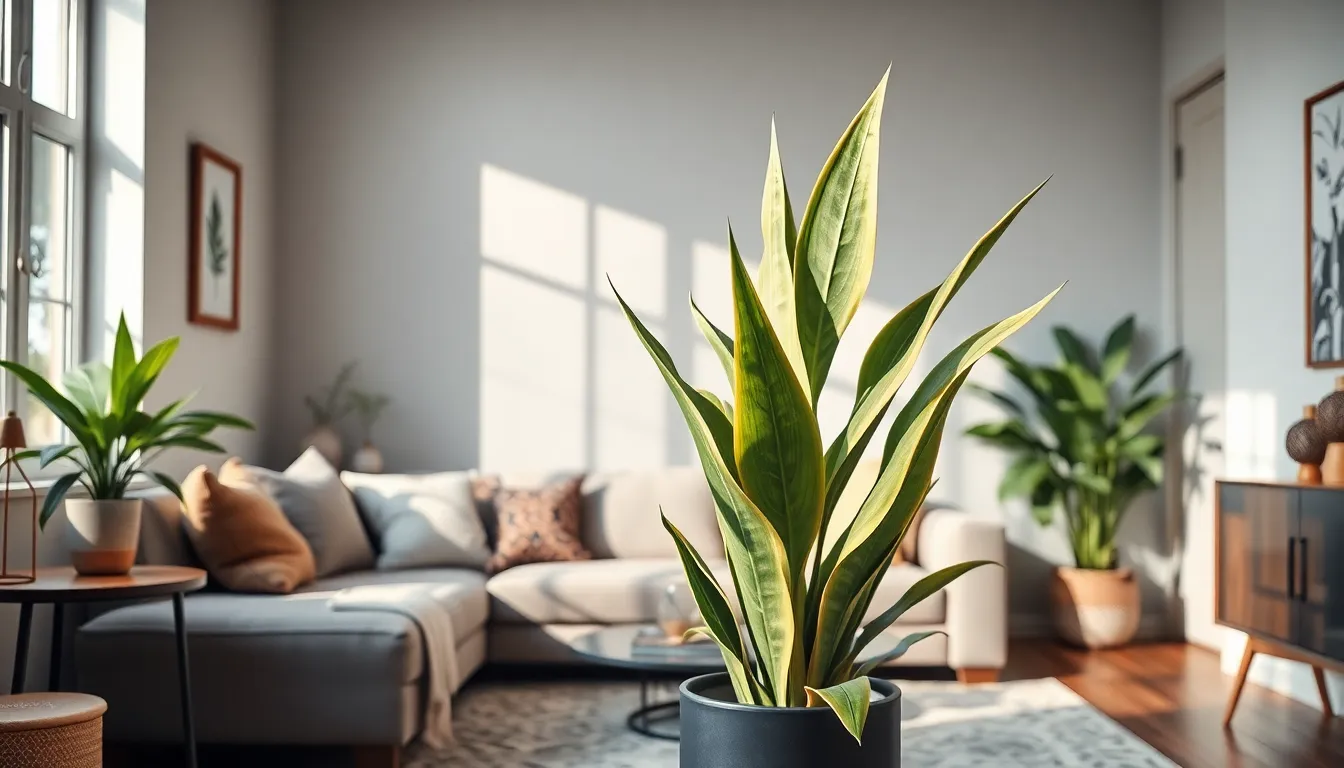
The snake plant stands as one of Vastu Shastra’s most powerful protective plants, creating a natural barrier against negative energies throughout our homes. Its upright sword-like leaves symbolize strength and resilience, making it an ideal guardian plant for our living spaces.
Night-Time Oxygen Production Benefits
Unlike most houseplants that release oxygen during daylight hours, the snake plant produces oxygen throughout the night using its unique Crassulacean Acid Metabolism (CAM) photosynthesis process. This exceptional trait means we can enjoy continuous air purification even while we sleep, promoting better respiratory health and more restful nights.
During nighttime hours, the snake plant actively removes toxins like formaldehyde and benzene from our indoor air while simultaneously releasing fresh oxygen. Research shows this continuous oxygen production improves sleep quality and reduces morning fatigue. The plant’s ability to absorb harmful electromagnetic radiation from electronic devices further enhances our bedroom environment, creating a cleaner and more positive atmosphere for recovery and rejuvenation.
Bedroom and Living Room Placement Rules
Proper placement of snake plants maximizes their protective and purifying benefits according to Vastu principles. We should position these plants in the southeast or northwest corners of bedrooms to maintain positive energy flow while avoiding direct placement facing the bed, which can create energetic disturbances during sleep.
Optimal Placement Guidelines:
| Room | Best Direction | Benefits | Avoid |
|---|---|---|---|
| Bedroom | Southeast/Northwest corners | Better sleep, air purification | Directly facing bed |
| Living Room | East/Southeast directions | Enhanced positive energy, welcoming ambiance | Southwest corners |
| General | Any room except bathrooms | Protection from negative energy | Near water elements |
Living rooms benefit greatly from snake plants positioned in east or southeast directions, where they enhance positive energy circulation and create a harmonious atmosphere for family gatherings. We must avoid placing these plants in southwest corners or near water features, as this combination can disrupt the natural balance of energies and diminish their protective qualities.
The elevated positioning of snake plants on plant stands or decorative pedestals amplifies their energy transmission capabilities while ensuring proper drainage and maintenance access.
Neem Tree: Natural Purifier and Health Guardian
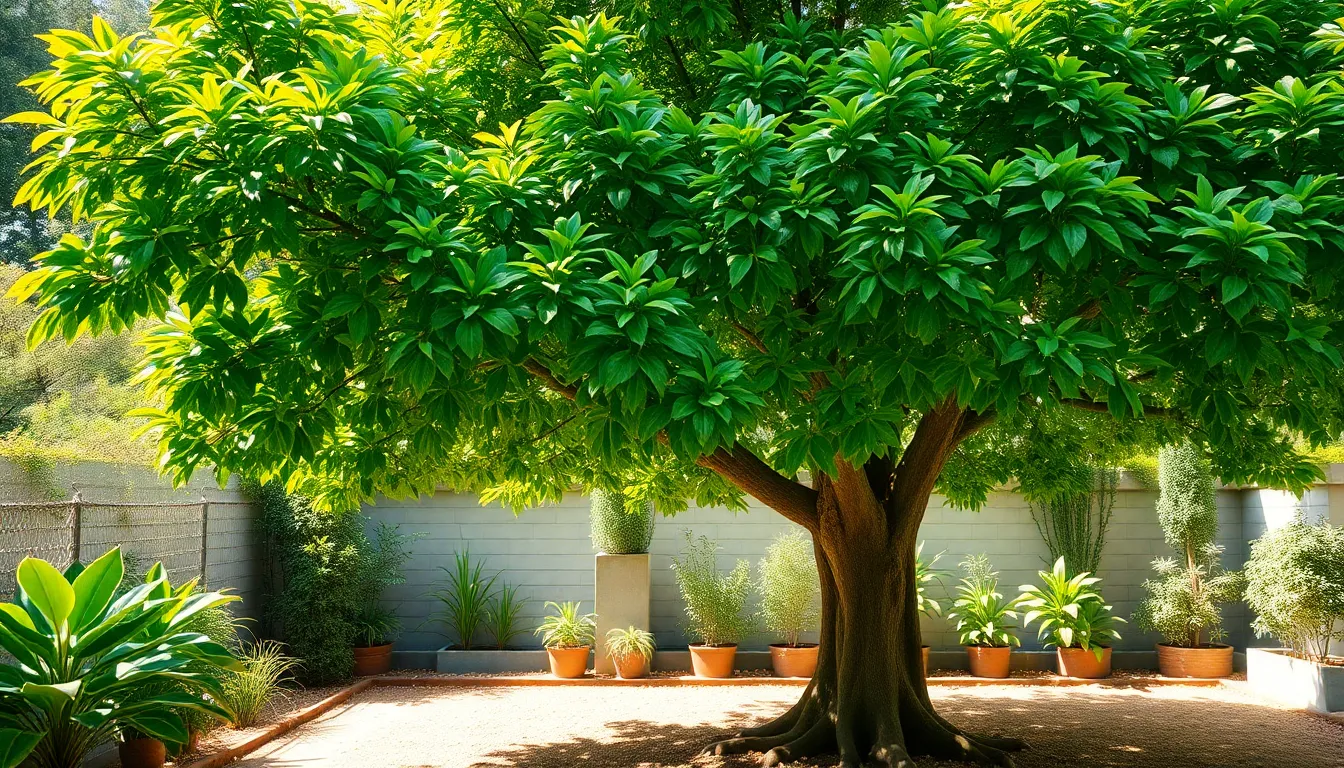
We’ve discovered that the neem tree stands as one of nature’s most powerful purifying plants in Vastu tradition. This remarkable tree creates a protective shield around our homes while actively cleansing both air and energy.
Traditional Medicinal Properties in Vastu Context
Neem carries extraordinary antibacterial, antifungal, and antiviral properties that transform our living environments into health sanctuaries. Ancient Ayurvedic wisdom recognizes this tree as a living pharmacy that supports our physical wellbeing while simultaneously guarding against negative energies.
Traditional households have relied on neem’s leaves, bark, and oil to treat various ailments for centuries. We benefit from this natural remedy’s ability to detoxify our surroundings while promoting mental clarity and calmness throughout our daily lives.
Vastu principles emphasize neem’s unique capacity to absorb harmful environmental waves and repel negativity from our property. This dual action creates a harmonious energy field that supports stress reduction and enhances our overall wellness naturally.
Our ancestors understood that neem functions as both a practical health solution and a spiritual protector. Today’s research confirms these traditional beliefs by documenting neem’s remarkable ability to purify air toxins while maintaining energetic balance in our homes.
Outdoor vs Indoor Placement Considerations
Neem trees thrive best in outdoor spaces due to their substantial size requirements and high sunlight needs. We recommend planting these powerful purifiers in northeast or northwest directions within our gardens or yard areas to maximize their beneficial effects on health and energy balance.
| Direction | Benefits | Placement Area |
|---|---|---|
| Northeast | Enhanced spiritual energy and health | Garden or open yard space |
| Northwest | Improved air purification and protection | Perimeter of property |
Indoor neem cultivation presents practical challenges since full grown trees require extensive space and natural sunlight. We can incorporate neem’s benefits indoors through neem based products like natural twigs or concentrated extracts that maintain the plant’s purifying properties.
Alternative Vastu approved plants excel in indoor environments where neem cannot flourish naturally. Money plants, tulsi, and peace lilies complement our outdoor neem trees by providing air purification and positive energy circulation within our living spaces.
Strategic outdoor neem placement creates a protective barrier that extends its purifying influence throughout our entire property. We position these natural guardians where they receive adequate sunlight while contributing to our home’s overall energetic harmony and health protection system.
Peepal Tree: Spiritual Significance and Divine Blessings
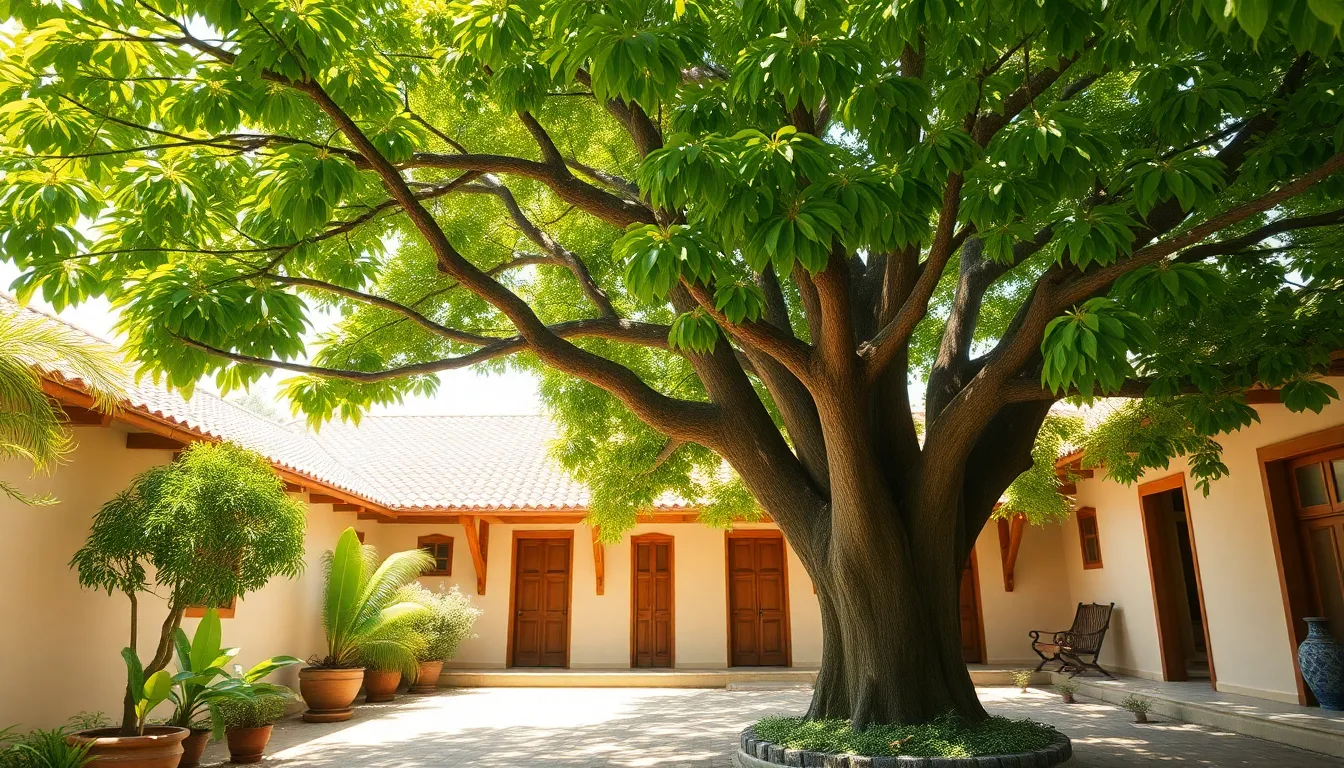
Among all Vastu plants for home environments, the Peepal tree stands as one of the most spiritually powerful additions we can make to our living spaces. This sacred tree radiates divine energy that transforms our home’s spiritual atmosphere.
Religious Importance in Hindu Traditions
Peepal trees hold deep reverence in Hindu culture as manifestations of divine blessings and spiritual energy. We find this sacred Ficus religiosa associated with multiple deities throughout Hindu traditions, making it a cornerstone of spiritual practice. Sacred energy flows naturally from this tree, creating an environment that enhances our spiritual growth and overall well being.
Hindu scriptures often reference the Peepal tree as a source of positive vibrations that connect us directly to divine consciousness. Devotees traditionally worship under these trees, believing they receive enhanced blessings and spiritual protection. Many Hindu households consider the presence of a Peepal tree essential for maintaining spiritual balance and inviting divine favor into their homes.
Spiritual significance extends beyond worship, as the tree’s natural energy purifies our surroundings and elevates our meditation practices. We often observe that homes with properly placed Peepal trees experience increased harmony, peace, and spiritual awareness among family members.
Courtyard and Garden Placement Guidelines
Courtyard placement offers the ideal location for Peepal trees according to Vastu Shastra principles, allowing their positive energy to radiate throughout our entire home premises. We recommend positioning these sacred trees in the northeast direction to maximize their auspicious influence on our family’s health, prosperity, and spiritual well being.
Garden areas provide excellent alternatives when courtyards aren’t available, particularly when we place the tree where it can grow without obstruction. Northeast positioning aligns perfectly with Vastu guidelines that emphasize directional harmony for spiritually important plants.
Proper spacing ensures the tree’s energy flows freely without creating negative impacts on our home’s structural elements. We should maintain adequate distance from the main building to prevent root interference while preserving the tree’s beneficial energy transmission.
Natural growth patterns must be respected when planning Peepal tree placement, as forced positioning can diminish their spiritual effectiveness. Environmental factors like soil quality, drainage, and sunlight exposure directly influence the tree’s ability to channel positive energy into our living spaces.
Marigold Plant: Vibrant Energy and Positive Aura

Marigold plants radiate exceptional vibrancy that transforms any living space with their distinctive orange and yellow blooms. We recommend incorporating these powerful Vastu plants to attract good luck while simultaneously driving away negative energies that can stagnate our home environments.
Color Psychology in Vastu Shastra
Bright yellow and orange hues of Marigold flowers stimulate optimism, happiness, and creativity throughout our living spaces. These vibrant colors create warm, inviting atmospheres that naturally enhance our mood and overall well-being according to Vastu principles.
Spiritual purity and protection qualities make Marigold ideal for placement near entrances or prayer areas where positive vibrations become amplified. Energy balance improves significantly when we position these colorful plants in eastern and southern parts of our homes, where natural sunlight enhances their energetic effects.
Color influence on energy flow becomes particularly powerful with Marigold’s radiant blooms, which symbolize positivity and brightness in our daily lives. We can harness these color benefits to create harmonious environments that support both our mental wellness and spiritual growth.
Seasonal Care and Placement Tips
Bright, indirect sunlight and well-drained soil provide optimal growing conditions for maintaining healthy Marigold plants in our homes. Regular watering without waterlogging ensures these plants continue delivering their energetic benefits throughout different seasons.
Faded flowers require removal to maintain the plant’s energetic potency and visual appeal in our living spaces. We must ensure consistent seasonal care to preserve the positive aura that healthy Marigold plants generate.
Ideal placement near our main entrance or in the southeast direction maximizes energy flow according to Vastu principles. Fire and energy associations with the southeast direction make this location particularly powerful for Marigold’s vibrant influence on our home environments.
Elevated positioning enhances the plant’s ability to transmit positive energy throughout our living spaces while maintaining proper drainage for healthy growth.
Conclusion
We’ve explored how the right plants can transform our homes into sanctuaries of positive energy and prosperity. From the wealth-attracting money plant to the spiritually powerful Tulsi each variety offers unique benefits when placed according to Vastu principles.
These living guardians don’t just beautify our spaces—they actively work to purify the air create protective barriers against negativity and channel abundance into our daily lives. Whether we’re seeking financial growth spiritual connection or simply a more harmonious atmosphere the plant kingdom provides powerful allies.
By choosing the appropriate plants for each room and direction we’re not just decorating—we’re consciously designing environments that support our well-being and aspirations. Start small with one or two plants and watch as they gradually enhance the energy flow throughout your entire home.
Frequently Asked Questions
Which direction is best for placing a money plant according to Vastu Shastra?
The southeast corner of the living room is the optimal placement for money plants to maximize their wealth-attracting potential. North and east directions are also beneficial for growth energy. Avoid placing money plants in bedrooms or bathrooms as these areas can diminish their prosperity-generating properties.
How many bamboo stalks should I keep for different purposes?
Different bamboo stalk arrangements serve specific purposes: three stalks for happiness, five for health and financial abundance, eight for career success, nine for exceptional fortune, and twenty-one for a comprehensive network of blessings. Each arrangement should be placed in appropriate areas of your home.
What are the best directions for placing Tulsi plants?
Tulsi plants should be placed in the north or northeast directions to maximize their ability to channel divine blessings. Positioning them near entry points offers protection against negative influences. Always keep Tulsi plants on elevated platforms and cultivate them in odd numbers for enhanced benefits.
Where should I place my Jade Plant for maximum prosperity?
According to Vastu Shastra, place your Jade Plant in the southeast area of your home for maximum prosperity attraction. This positioning helps the plant’s coin-shaped leaves symbolize and attract financial growth. Keep the plant in clean, positive spaces with adequate lighting and well-draining soil.
Can I keep Aloe Vera in my bedroom?
No, Aloe Vera should not be placed in bedrooms due to its sharp leaves. The best locations are east and north directions, particularly in living rooms, kitchens, and balconies. This placement maximizes its air-purifying qualities and health benefits while maintaining positive energy flow.
What is the significance of Peace Lily placement in Vastu?
Peace Lilies should be placed in east or north directions, particularly in living rooms and hallways, to promote harmony and tranquility. Avoid bedrooms and kitchens. The plant excels at air purification and symbolizes purity and calmness, requiring indirect sunlight for optimal energy enhancement.
How does the Snake Plant protect against negative energies?
Snake Plants create a natural barrier against negative energies and produce oxygen at night, enhancing air quality. Place them in southeast or northwest corners of bedrooms and living rooms, avoiding direct placement facing the bed. Elevated positioning maximizes their protective and purifying benefits.
Where should I plant a Neem tree for maximum purification benefits?
Neem trees should be planted outdoors in the northeast or northwest directions to maximize their purifying effects. Their antibacterial, antifungal, and antiviral properties contribute to a healthier living environment. For indoor spaces, consider neem-based products as alternatives.
What makes the Peepal tree spiritually significant?
The Peepal tree is considered sacred in Hindu traditions and provides divine blessings and positive vibrations. Place Peepal trees in courtyards or gardens, particularly in the northeast direction, to maximize their auspicious influence and enhance spiritual growth and well-being.
How do Marigold plants attract good luck?
Marigold plants attract good luck through their vibrant orange and yellow blooms that dispel negative energies and stimulate optimism. Place them near entrances or prayer areas, particularly in eastern and southern parts of the home, to amplify positive vibrations and creative energy.

